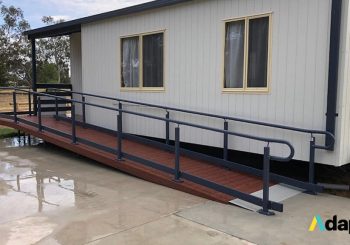Wheelchair ramps can provide the needed accessibility for individuals that use mobility devices like wheelchairs
Wheelchair ramps can provide the needed accessibility for individuals that use mobility devices like wheelchairs etc. There are a large number of wheelchair ramps to choose from. When you are getting one installed, and it’s important to keep aspects such as the available space, layout of the property, your specific requirements, budget etc. Here is some useful information about the different wheelchair ramp layouts. This should help you make the right choice based on your specific needs,
This is the simplest type of ramp that you can build and use. It leads out in a straight line from a point on your property to the front door of your home. This type of ramp doesn’t have any angles or turns. It is the most efficient for those who want a very simple yet effective way to enter their home.
2. Angled Ramp
An angled ramp may be installed along the side of the house after which it would bend around the back or front yard. This kind of a ramp doesn’t have any U-shaped or L-shaped angles. Special attention needs to be paid to the transition in order to ensure that it allows for easy movement between these two sections and that it isn’t dangerous.
3. L-Shaped Ramp
This is likely the commonest type of wheelchair ramp. It’s very easy to install and use. This feature is often installed leading out from a front or back door. The longer section leads from the door after which a single turn connects to the second section of the ramp. The slowly-rising slope makes it a good option for people that use manual wheelchairs rather than motorised mobility equipment.
4. U-Shaped Ramp
This type of a ramp is also referred to as a switchback ramp. The ramp changes its angle at a 180 degree turn at the landing platform. In U-shaped ramps, the two sections run parallel to each other and are connected by the landing platform. While these ramps can be difficult to navigate for people using motorised wheelchairs and scooters, they require far less space than other ramps.
Designing The Ramp Correctly
The width, design, and turns of all ramps are important in order that they be efficient to use. The turns and angles need to be sufficiently wide to easily accommodate the wheelchair width while it’s being manoeuvred around the ramp’s corners.
The best way to get this aspect right is to measure what the width of your wheelchair is and then design the turns in such a manner that it becomes possible to turn the chair in a complete circle. You also need to factor in the space required for an attendant that might be pushing the wheelchair. It’s important that the ramp have no tight or sharp angles as this can lead to accidents not just for the person in the wheelchair but for the person pushing the wheelchair as well.
When you are considering getting a wheelchair ramp installed on your property, you need to consult with experts like the ones at our company. They would be able to provide you all the information you need about these features. Our team will also visit your property in order to assess which layout would work best in the available space and for your needs. This customised approach goes a long way in ensuring you get a wheelchair that suits your needs and fits your budget.
We provide a wide variety of ramp layouts and options. You can call 1800 232 782 or contact Adapta through this form and one of our representatives will contact you shortly.




